
What is a Sailboat Boom Vang?

Last Updated by
Daniel Wade
June 15, 2022
A boom vang is a set of blocks and lines or an adjustable pole used to pull the boom down and shape the sail.
The boom vang (or “kicking strap”) is a system used to control the shape of the sail. It counteracts the upward force of the boom jack and the mainsail by pulling the boom downward. This results in the ability to control the shape of the sail.
Table of contents

Boom Vang vs. Mainsheet
What's the difference between the boom vang and the mainsheet? On many sailboats, the boom vang and the mainsheet look similar, as both use a set of blocks to control the motion of the boom.
The easiest way to tell the difference between the boom vang and the mainsheet is location. The boom vang typically begins close to the base of the mast and connects to the base of the boom at about a 45-degree angle.
The mainsheet is much further back and generally vertically-oriented. Sometimes, the mainsheet is located far at the end of the mast and connected to the stern of the vessel. Just remember boom vang forward, mainsheet aft.
What Does a Boom Vang Do?
A boom vang is a simple device consisting of a pole or a set of blocks and lines. The primary purpose of the boom vang is to control the vertical orientation of the boom and to exert a downward force on it.
Without the boom vang, the wind would blow the sail uncontrollably and make it difficult to maneuver efficiently. The mainsheet, which appears to exert downward pressure on the boom, wouldn't be able to adjust the sail effectively without a separate system like a boom vang.
Importance of the Boom Vang
A properly-adjusted boom vang becomes more important as you let out the mainsheet. The further from the centerline the boom travels, the less downward force the mainsheet provides.
This means that you'd lose a tremendous amount of control without a boom vang, especially as you loosen the sheet. A boom vang exerts a constant downward force on the sail regardless of what position the boom is in. This keeps the sail shape consistent in all conditions.
Boom Vang Types
There are two primary types of boom vangs used on sailboats today. The first and most common type is the standard boom vang. Standard boom vangs consist of a block and tackle arrangement that mounts to the base of the mast and bottom of the boom.
The second type is the hydraulic boom vang , which is more advanced and offers unique benefits. The hydraulic boom vang uses a hydraulic piston that looks like an oversized automobile shock or door opener.
The benefit of a hydraulic boom vang is that it holds the vertical position of the boom without assistance. It's rigid in both directions and doesn't require upward force to keep the boom in place.
Hydraulic boom vangs are costlier than traditional block-and-tackle setups. That said, they're easy to install and generally simple to operate. Hydraulic boom vangs are common on newer sailboats, especially those that exceed 30 feet in length.
What is a Boom Gnav?
A boom gnav is one of the most intuitive pieces of sailboat equipment. The word "gnav" is "vang" spelled backward, and it performs the exact same task on the opposite end of the boom.
A boom gnav exerts a downward force on the boom to counteract the upward force of the wind or rigging. A boom gnav pushes the boom down, whereas a boom vang pulls it down. Not all sailboats have a boom gnav, and those that do often use it as a substitute for a boom vang.
Boom gnav systems are most common on small sailboats , where the added lower triangle of a boom vang gets in the way. A boom gnav takes up no extra cockpit space as it mounts atop the boom and to a higher point on the mast.
In other words, the boom gnav operates within the sail area, which is a part of the boat that's already unusable due to the sail. A boom gnav is usually a pole that adjusts by sliding forward and aft on the boom, which changes the angle and downward force.
Boom Vang Maintenance
Maintenance is essential to keep your sailboat in safe and working condition, and the boom vang is no exception. There are a few boom vang parts you should inspect and maintain regularly.
Check the Mounting Points
The mounting points of the boom vang are subjected to a considerable amount of force, and they should be inspected regularly. Look for signs of corrosion (galvanic or otherwise) and bending.
If you notice any deformation, replace the mounting points and hardware with marine-grade hardware. Make sure the aluminum mast is solid, as corrosion can weaken the areas around the mounting holes.
Inspect Blocks and Tackle
For traditional boom vangs, regularly inspecting the blocks and lines can prevent problems down the road. Over time, nylon lines become salt and sun-damaged and begin to fray. If the lines are brittle and leave excessive dust on your hands, it may be time to replace them.
Blocks are generally reliable and don't require a significant amount of maintenance. That said, you should inspect your blocks and make sure they spin freely. If they don't (or they become too loose), they could be failing and should be replaced with high-quality marine blocks.
Hydraulic Boom Vang Maintenance
Hydraulic boom vangs are simpler than traditional block and tackle setups, but they still require regular inspection. A hydraulic boom vang uses a piston and a working fluid instead of lines and pulleys.
On hydraulic boom vangs, the primary failure points are the seals and the mounting points. If your boom vang begins to leak, you'll notice a decrease in stability, and the vang won't hold tension.
Another common failure point is the spring, which can weaken or break and make the vang almost unusable. In most cases, the best option when your hydraulic boom vang fails is to replace it entirely.
What is a Boom Jack?
A boom jack (also known as a lazy jack) is the rigging that exerts an upward force that the boom vang or boom gnav counteracts. The boom jack begins at the boom and reaches up to the top of the mast.
Boom jacks resemble any other rigging on a sailboat. They roughly form the triangular shape of the sail and usually mount to the boom at multiple points.
A typical boom jack begins as a single line at the top of the mast. About 1/4 of the way down the mast, it splits into two lines. At the halfway point, each end of the two lines splits again into four. These four lines run down to the boom and mount evenly-spaced apart.
The purpose of the boom jack is to exert even upward force on the boom. The tension of the boom jack is set as to counteract the tension of the boom vang, which holds the boom at a steady 90 degrees. The boom jack line runs down from the top of the mast to a block or cleat on the opposite end of the boom vang.
Adjusting the Vang
Generally speaking, the boom vang isn't as important when traveling upwind as it is when traveling downwind. This is especially true once you've maxed-out your mainsheet traveler.
At this point, the vang controls the twist of the mainsail. With an improperly-adjusted vang (or lack thereof), you could experience a lot of up-and-down play of the boom. This can cause you to lose control of the mainsail.
A properly-adjusted boom vang can help you keep your mainsail shaped correctly and keep your boom in the proper position. It also gives you precise control of your speed when traveling downwind.
Related Articles
I've personally had thousands of questions about sailing and sailboats over the years. As I learn and experience sailing, and the community, I share the answers that work and make sense to me, here on Life of Sailing.
by this author
Sailboat Parts
Learn About Sailboats
Most Recent

What Does "Sailing By The Lee" Mean?
October 3, 2023

The Best Sailing Schools And Programs: Reviews & Ratings
September 26, 2023
Important Legal Info
Lifeofsailing.com is a participant in the Amazon Services LLC Associates Program, an affiliate advertising program designed to provide a means for sites to earn advertising fees by advertising and linking to Amazon. This site also participates in other affiliate programs and is compensated for referring traffic and business to these companies.
Similar Posts

Affordable Sailboats You Can Build at Home
September 13, 2023

Best Small Sailboat Ornaments
September 12, 2023

Discover the Magic of Hydrofoil Sailboats
December 11, 2023
Popular Posts

Best Liveaboard Catamaran Sailboats
December 28, 2023

Can a Novice Sail Around the World?
Elizabeth O'Malley

4 Best Electric Outboard Motors

How Long Did It Take The Vikings To Sail To England?

10 Best Sailboat Brands (And Why)
December 20, 2023

7 Best Places To Liveaboard A Sailboat
Get the best sailing content.
Top Rated Posts
Lifeofsailing.com is a participant in the Amazon Services LLC Associates Program, an affiliate advertising program designed to provide a means for sites to earn advertising fees by advertising and linking to Amazon. This site also participates in other affiliate programs and is compensated for referring traffic and business to these companies. (866) 342-SAIL
© 2024 Life of Sailing Email: [email protected] Address: 11816 Inwood Rd #3024 Dallas, TX 75244 Disclaimer Privacy Policy
- New Sailboats
- Sailboats 21-30ft
- Sailboats 31-35ft
- Sailboats 36-40ft
- Sailboats Over 40ft
- Sailboats Under 21feet
- used_sailboats
- Apps and Computer Programs
- Communications
- Fishfinders
- Handheld Electronics
- Plotters MFDS Rradar
- Wind, Speed & Depth Instruments
- Anchoring Mooring
- Running Rigging
- Sails Canvas
- Standing Rigging
- Diesel Engines
- Off Grid Energy
- Cleaning Waxing
- DIY Projects
- Repair, Tools & Materials
- Spare Parts
- Tools & Gadgets
- Cabin Comfort
- Ventilation
- Footwear Apparel
- Foul Weather Gear
- Mailport & PS Advisor
- Inside Practical Sailor Blog
- Activate My Web Access
- Reset Password
- Pay My Bill
- Customer Service

- Free Newsletter
- Give a Gift

How to Sell Your Boat

Cal 2-46: A Venerable Lapworth Design Brought Up to Date

Rhumb Lines: Show Highlights from Annapolis

Open Transom Pros and Cons

Leaping Into Lithium

The Importance of Sea State in Weather Planning

Do-it-yourself Electrical System Survey and Inspection

Install a Standalone Sounder Without Drilling

When Should We Retire Dyneema Stays and Running Rigging?

Rethinking MOB Prevention

Top-notch Wind Indicators

The Everlasting Multihull Trampoline

Check Your Shorepower System for Hidden Dangers

How Dangerous is Your Shore Power?

DIY survey of boat solar and wind turbine systems

What’s Involved in Setting Up a Lithium Battery System?

The Scraper-only Approach to Bottom Paint Removal

Can You Recoat Dyneema?

Gonytia Hot Knife Proves its Mettle

How to Handle the Head

The Day Sailor’s First-Aid Kit

Choosing and Securing Seat Cushions

Cockpit Drains on Race Boats

Re-sealing the Seams on Waterproof Fabrics

Safer Sailing: Add Leg Loops to Your Harness

Waxing and Polishing Your Boat

Reducing Engine Room Noise

Tricks and Tips to Forming Do-it-yourself Rigging Terminals

Marine Toilet Maintenance Tips

Learning to Live with Plastic Boat Bits
- Sails, Rigging & Deck Gear
Solid Vang Showdown
Vang master pushes to the top; steer clear of the ocean vang.
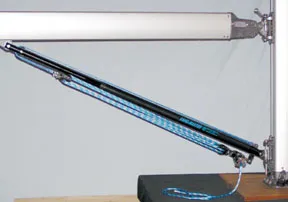
]It’s been more than six years since Practical Sailor evaluated rigid boom vangs. Given the rapid evolution of sailing hardware, it’s high time we take another close look.
In that May 15, 1999 report, we wrote that Hall Spars and Rigging’s QuikVang was the best all-around product, if you were game to ignore prices. Garhauer Marine’s vang was our Best Buy due to its rugged construction and economical price, and Spinlock’s then new Powervang was the product of choice for the racing set. If you owned a larger boat and wanted a lightweight vang, your best bet was Selden’s Rodkicker. As that 1999 test indicated, determining the appropriate rigid vang for your boat and your style of sailing is not a one-size-fits all affair. The process is fraught with conditional answers that only you can supply.
First, you have to determine if you want a rigid vang primarily for supporting your boom. If that’s the case, then the performance of the vang may be less important to you than the cost and the product’s purported longevity. If you want a vang that will allow you to make fairly precise refinements to your mainsail trim as well as support your boom, you’ll be looking more closely at how easy it is to adjust and its range of adjustability. Then, you have different types. Do you favor a spring-loaded, gas-cylinder, pneumatic, or rod vang?
Our evaluation included all four types. It’s important to note that you shouldn’t install a rigid vang on a boom that rotates, as this will compromise the gooseneck fittings on the vang or the boom itself. Also, standard, off-the-shelf rigid vangs like the ones PS evaluated here are not suitable for use with in boom furling. For those applications, you’ll want heavier duty equipment.
The Test For this test, PS amassed a group of eight rigid vangs from seven manufacturers. We asked each company to send a vang that would be suitable for a 36-foot sloop with a 13-foot boom. We told them that we were upgrading from a 4:1-purchase soft vang, that our objectives were convenience and safety, and stipulated that there were no suitable fittings on the mast or boom for attaching the new vang. We also mentioned that the mainsail on this boat weighed 50 pounds, and we described the spars as having rectangular grooves for the attachment fittings.
Selden Masts, which manufactures three different sizes of the Rodkicker, loaned us a mast and boom display mounted on a pallet, and we used this as a test platform for each vang. We looked closely at the vangs as well as the mounting fittings, which can vary according to the type of spar you have. We operated each vang multiple times and examined the construction quality, noted the stroke range, maximum return force, as well as the ease of use, and overall weight.
Vang Master Marine Products Engineering is a small manufacturing firm based in San Pedro, California, that also builds pneumatic actuators for doors, lids, and some other applications. Proprietor and designer Doug Grant has been building vangs for 14 years, and he is the supplier for Melges Boatworks and Ultimate Sailboats. His Vang Masters range in size from from 24 inches to 9 feet.
Grant uses 6061 T6 aluminum tubing that is hard-coat anodized and impregnated with Teflon. The end fittings are also machined from aluminum and hard-coat anodized. Except for the sheave and jaw attachment pins, MPE doesn’t use any stainless steel. These vangs operate with an 8:1 cascading purchase system using Harken blocks (including a ratchet block and cam cleat), the last part of which runs through a sheave in the upper end of the vang.
Grant says he presets the cylinder pressure on each vang, but he also includes a bicycle pump so that an owner can make his own adjustments. To change the pressure, you simply pump the vang up to whatever pressure you need to keep the boom level.
The lightest vang, the Vang Master also provided the smoothest action. This was surprising, because others like the Hall QuikVang or those from Garhauer come with greater mechanical advantage. The Vang Master VM-4 offers 16 to 18 inches of stroke range with up to 500 pounds of return force, and comes with a four-year warranty that covers any breakage under normal use. It sells for $845, including the pump, but not the end fittings ($110 for the boom, $145 for the mast).
Garhauer Marine Known for its rugged, if heavy, products, Garhauer Marine provides deck hardware for Catalina Yachts. The company supplied two vangs for our test: the RV20-1SL with a stainless outer tube, and the deluxe RV20-1AL, with a 6061 T aluminum outer tube, integrated purchase fittings, and a larger aluminum sheave in the head. Both vangs are intended principally to support the boom and both rely on 1½-inch diameter stainless steel springs — four in each case — to offer the resistance.
Garhauer includes in its price custom mast and boom fittings that are polished, beefy 316 stainless pieces with finely welded or machined components. The vangs featured similarly rugged construction. Except for the composite sheaves built into the vangs’ forked ends, all the sheaves in the 20:1 purchase are anodized aluminum, which spin on Torlon ball bearings.
These vangs have a wide stroke range — 8 to 12 inches — and they reliably returned our boom to the same position. Their construction appears to be bullet-proof (they carry a 10-year warranty) and they have the lowest prices of any vangs that passed our test ($374 for the RV20-1SL, and $429 for the duluxe RV20-1AL, including end fittings). Yes, they’re also the heaviest products, but not by much. Their main disadvantage is that, once they are installed, the resting height is not as adjustable as it is in other vangs.
Forespar Forespar’s Yacht Rod is made of a polished stainless steel inner tube and an Awl-Grip coated aluminum outer tube, and anodized aluminum forked ends. The Yacht Rod uses a single stainless steel spring for resistance. It’s marketed as both a device for supporting the boom and for trimming the sail in cruising or racing applications.
The Yacht Rod, which is built in three sizes, has a 4:1 tackle using Harken fiddle blocks and 7/16” line. A section of Spectra line attaches to that and runs through an aluminum sheave in the upper end’s fork to create an 8:1 purchase.
Forespar offers several sizes of mast and boom end fittings for its Yacht Rods (sold as part of the package or separately). The majority of these are fashioned from polished stainless steel. The welds on the fittings that were sent to PS were solid and well executed.
The outer tube has four holes at four-inch increments that accept a fast pin to adjust the boom’s height and allow a wide range of resting positions. This would be a handy feature to temporarily lift the boom in order to raise or lower a dodger or bimini. Forespar’s otherwise excellent installation instructions lacked a detailed drawing of the mast end, which would be a big help.
This vang was simple to install and operated fairly smoothly, but the spring did squeak slightly when compressed. The medium-size Yacht Rod has a stroke range of 7 inches, and provides 600 pounds of return force. It comes with a warranty of three years and sells for $873, including the tackle and end fittings.
Hall QuikVang Roughly five years ago, Hall Spars introduced the pneumatic QuikVang 2000, but, citing “complexities with its use,” has stopped production. Hall plans to introduce a new vang, which we’ll test and present in a future issue. For this evaluation, we looked at the conventional
QuikVang, a top performer in previous tests, and a product that Hall has been building for 20 years.
Marketed principally as a sail-trimming device, the QuikVang has anodized aluminum tubing and end fittings as well as a stainless steel spring. A Delrin plug in the inner tube acts as a piston to compress the spring when the 18:1 purchase system is tensioned. Delrin sleeves between the two tubes reduce friction and snug tolerances between the spring and the outer tubing keep the spring in column. Once installed, you can adjust the vang’s resting height in one-inch increments by loosening the set screws on the adjuster knob.
The purchase system features Harken blocks and Yale Dacron braided line, and includes a ratchet block and cam cleat so you don’t need any additional deck hardware for basic operation. Three parts of the purchase use stainless wire over aluminum sheaves, which are mounted in the jaws of the vang. Hall’s end-fittings are machined from aluminum and then hardcoat anodized.
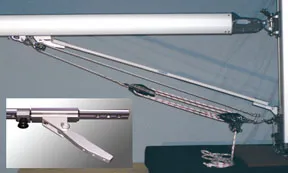
The QuikVang was easy to install and adjust. It operated smoothly and reliably returned the boom to its initial position. One convenient feature is a ratchet that lets you release the control line under heavy load. And Hall’s booklet of instructions is very complete, including information on installation, operation, and maintenance. This model has a stroke range of 6 inches, 600 pounds of return force, comes with a three-year unconditional warranty, and sells for $906, not including end fittings.
Seoladair’s Boomkicker Seoladair, a small manufacturing firm just outside of Chicago, IL, produces stowable fenders, rolling boom bales, and the Boomkicker. This product is simple and will suit owners who want something to support their boom and work in tandem with an existing soft vang.
The Boomkicker, which is sold in five sizes for boats from 14 to 38 feet, is simply a set of fiberglass rods. The rods are held captive at either end with hardcoat anodized aluminum collars and attach to the mast and boom via durable, machined and anodized aluminum fittings. Users can further customize the Boomkicker by cutting the rods to a shorter length.
PS found the Boomkicker simple to install and easy to use. The 1500 we tested came accompanied by a 4:1 tackle using Harken blocks (and cam cleat) as well as a short section of Spectra run through an additional block to create an 8:1 purchase. Also included was an aluminum attachment tang for the purchase system, as well as a drill bit, stainless fasteners, and a tap to secure the fittings to the boom. (In most cases, the mast fitting uses the luff groove for attachment and no drilling or tapping is necessary.) At 4.5 pounds, the Boomkicker is the lightest in this test. The model we tested offers 600 pounds of return force with a stroke range of up to 16 inches, and carries a five-year warranty. It sells for $309, not including tackle, which we found for $173.
Last year, Seoladair introduced a new sliding boom fitting, which includes a 16-inch section of aluminum track and a car for the upper end. Without this, the Boomkicker drop outs out of the boom when it’s raised well above horizontal. This is to prevent overloading of the fittings. We’d definitely shell out the extra $108 for the new boom fitting.
Selden’s Rodkicker Selden’s Rodkickers come in four sizes for boats from 22 to 60 feet and use gas-pistons for their return force. These pistons are mounted inside rectangular anodized aluminum extrusions that are mated to anodized aluminum end-fittings secured with Monel rivets. This vang came with an external 4:1 block and tackle using Rutgerson fiddle blocks with a cam cleat, which Selden sells as an option. The tackle connects to a large stainless wire that runs over a composite sheave integrated into the vang’s upper end fitting, creating an 8:1 purchase.
We tested the Rodkicker 20, which is rated for boats from 35 to 42 feet. To specify its vangs, the company first looks at righting moment and rig type, and thereafter considers the weight of the boom and sail. The Rodkicker 20 claims a stroke range of seven inches and a return force of 876 pounds using the normal gas piston. The inner extrusion is capped by a composite plug, which acts as a bushing.
It took PS testers about 20 minutes to read the instructions and assemble the Rodkicker 20, which arrived in three boxes. It mounted easily to the machined boom (aluminum) and mast (stainless steel) fittings that the company supplied. The first time we used it, this vang took the most force (roughly 60 pounds) to compress, but it operated smoothly after that. Bernie Beasley at Selden told us that operation of each vang relies on the weight of a full boom and sail resting on it. With that factored in, he said, we wouldn’t have experienced as much initial resistance.
Selden offers a two-year warranty on the Rodkicker. The 20 sells for $685, not including tackle. We were impressed by several aspects of this vang. Where clevis pins are used to connect the vang to the boom and mast, the end fittings have recesses to keep the cotter pins from sticking out and doing damage. And the boom fitting uses three Allen screws for attachment. These can either be tapped into the spar or dogged down for compression attachment. Selden also offers a universal boom bale for booms without an integral track.
Sparcraft Based in France, Sparcraft has manufacturing facilities for mast, booms, and rigging systems there and in the United States at Charleston Spars in Charlotte, North Carolina. The Ocean Vang uses anodized aluminum tubes that compress a stainless steel spring by way of an external 4:1 purchase system to deliver a return force of 300 pounds The vang has sheaves integrated into its end fittings, and there are no external blocks, which simplifies the arrangement, but limits the amount of purchase available. (Some vangs are sold with additional external tackle.) The polished, 316 stainless-steel brackets for mast and boom come in various sizes and configurations.
Installation was simple and straightforward, which was good because the vang arrived with no instructions. You’ll need to lead the the control line to a swiveling, pivoting block mounted on deck because the sheaves in the vang don’t articulate and the line won’t otherwise lead in a fair fashion when the boom is off centerline.
PS found two problems with the Ocean Vang. Its spring was squeaky and it didn’t regularly return the boom to its initial point after we installed it. When we opened the unit, we found that the design doesn’t keep the spring in column. When the spring moves off-center — as is almost certain to occur any time the spring is under load — the spring rubs directly on the outer tube, producing friction and squeaking. We applied some WD 40 and the vang worked more smoothly and squeaked less, though it still didn’t perform satisfactorily.
Jim Kulibert, Charleston Spars’ director of sales, told us that our experience was an anomaly. He says the company has furnished hundreds of these vangs to boats over the years and they never receive complaints of squeaks or binding.

This size Ocean Vang retails for $279, which includes the control line, but not the brackets for the mast ($39) or boom ($42). The vang carries a one-year warranty.
Conclusions For cruising sailors, it’s most important that a rigid vang works to support the boom and secondarily to trim the mainsail. If simple support is what you’re after, almost all of these products are suitable. Factor in ease of operation, and you can whittle that group down by excluding the Sparcraft’s Ocean Vang, which we have given a Don’t Buy rating.
If post-installation adjustment is the next criterion, you can overlook the vangs from Selden and Seoladair, which worked perfectly well in all other aspects. So, you’re left with our selection of vangs from Garhauer, Forespar, Hall, and Marine Products Engineering (the Vang Master). The Garhauers offer limited adjustment pre-installation, the
Yacht Rod adjusts in 4-inch increments, the QuikVang in 1-inch increments, and the Vang Master’s range is virtually unlimited.
If you want a basic rigid boom vang that is well built and functions smoothly for the least dollar outlay, Garhauer is the clear choice. Astoundingly, these rugged vangs are about half the price of those from the other builders, and with a 10-year warranty, they are hands down our Budget Buy.
If you are interested in a smoothly operating vang that you can use to reliably control your mainsail, those from Forespar or Hall fit the bill and earn our Recommended rating. But of all the vangs, the Vang Master from Marine Products Engineering has the best adjustability, the smoothest operation, the longest stroke range, and the longest warranty of these three, and thus, even with it’s high pricetag, it is our Best Choice overall.
Also With This Article “Vang Types” “PS Recommended” “PS Value Guide: Boom Vangs”
RELATED ARTICLES MORE FROM AUTHOR
What issue did this article appear in?
The prices in this article are from 2006 /2019?? I’m interested in the Garhauser vang but see only these vangs and prices: Rigid Boom Vang RV20-1 DX => $679.80 Rigid Boom Vang RV20-1 SL => $599.50
LEAVE A REPLY Cancel reply
Log in to leave a comment
Latest Videos

40-Footer Boat Tours – With Some Big Surprises! | Boat Tour

Electrical Do’s and Don’ts

Bahamas Travel Advisory: Cause for Concern?

Island Packet 370: What You Should Know | Boat Review
- Privacy Policy
- Do Not Sell My Personal Information
- Online Account Activation
- Privacy Manager
Using a Sailboat Boom Vang in Sailing
Konstantin Trubavin/Getty Images
- Top Artists
- Alternative Music
- Classical Music
- Country Music
- Rap & Hip Hop
- Rhythm & Blues
- World Music
- Heavy Metal
- Latin Music
A boom vang is used on a sailboat to pull down the boom on off-wind points of sail when the wind in the mainsail would lift the boom. Proper use of a boom vang helps keep the sail full and drawing well.
When a sailboat sails downwind, the mainsail is let out for best sail trim, and the boom is typically 50 to 80 degrees from the centerline out to the leeward side. Because of this angle, the mainsheet has a little downward pull on the boom, which freely rises and falls with wind changes and when the boat rolls on waves from behind. When the boom rises, the mainsail billows out, twists, and spills wind, then may snap back—over and over. This motion makes the sail less efficient.
A boom vang prevents this motion by pulling downward on the boom regardless of its position in relation to the centerline. A traditional block-and-tackle vang mounts between the base of the mast and mid-boom. The control line is typically led back to the cockpit, where pulling the line exerts force to pull the boom down.
A number of commercial rigid boom vangs are also available. This is essentially an adjustable pole that mounts similarly to hold down the boom. While more expensive than a block-and-tackle vang, rigid vangs have the added function of also holding the boom up when the mainsail is lowered, such that a topping lift is not needed.
How to Use a Boom Vang
When to tighten the vang:
- When sailing downwind on a broad reach or a run, tighten the vang to keep the boom down and minimize mainsail twist that spills air from the sail.
- If the boat does not have a traveler , which is used to pull the boom down on a beam reach, use the vang even on a beam reach (the wind directly over one side).
When to ease or release the vang to allow the boom to rise:
- When sailing downwind in light air, the mainsail generally has a better shape if the vang is not tight. Let the sail bag out some.
- When sailing downwind in a strong wind, ease the vang to depower the mainsail by allowing the boom to rise and the sail to spill air high up (mainsail “twist”). Bring in the mainsheet if needed to prevent chafing of the sail against the shrouds and spreaders.
- After dropping the mainsail, raise the boom to give more headroom in the cockpit.
Boom Vang as Preventer
If your boat lacks a boom preventer , an important piece of safety gear, it may be possible to improvise with the vang as a preventer when needed, if its lower connection can be easily released and moved forward of the mast.
- How to Use a Mainsheet Traveler
- How to Rig a Preventer Line
- How to Gybe a Sailboat
- Learn How to Sail a Small Sailboat – 1. The Parts of the Boat
- How to Use a Topping Lift
- Simple Reefing System for Sailors
- When to Adjust Sailboat Sails for Stronger Winds
- How to Raise the Mainsail
- How to Tack a Sailboat
- How to Use Roller Furling
- How to Tow a Dinghy Behind a Sailboat
- Choosing a Centerboard or Fixed Keel Sailboat
- How to Anchor a Sailboat
- How to Use a Sailboat's Outhaul
- How to Trim the Jib Using Telltales
- The Sunfish: A Perfect Lake or Urban Sailboat
BoatNews.com
What's the boom vang really for?
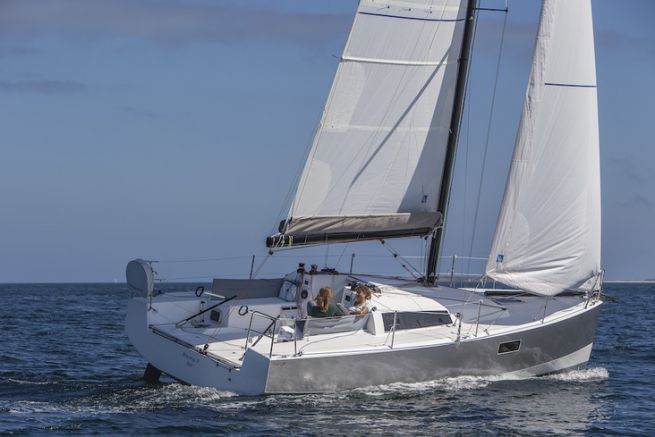
Whether cruising or regatta sailing, the vang is a mainsail adjustment that is sometimes misunderstood. For all those who wonder how to use the vang correctly, Bateaux.com gives you the keys.
The role of the boom vang
The vang is usually a hoist attached between the mast foot and the boom. Its variable length determines how high the boom can rise. It is therefore the vang that maintains the boom height when the mainsheet is let out. Upwind, the mainsheet only starts to lower the boom when it is above the mainsail carriage.
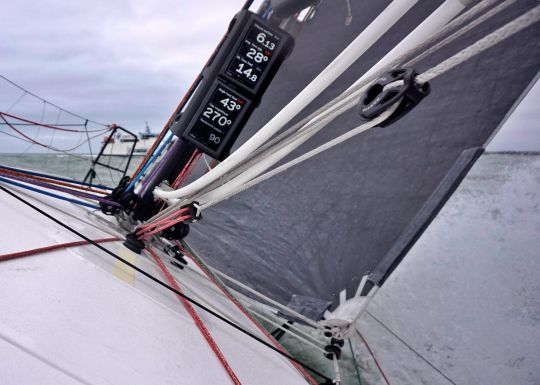
Why use bas??
The vang, together with the mainsheet, is one of two ways of controlling the boom height, which determines the twist.
If you do not use the downhaul (except in light winds), by shocking the sheet, the boom will rise and open the leech wide, releasing all the power from the top of the sail . This is ideal when the boat heels excessively and becomes too hot, but it is not the desired effect when power is still needed.
Not operating the boom vang also limits the ability to shock. If the top of the mainsail is very twisted, it will quickly press on the shrouds, preventing the boom from being shocked as much as desired, otherwise the whole bottom of the sail will start to tuck. But if the vang is taut enough, the moment when the top of the sail "wraps" around the shrouds will be delayed. In this way, the tension of the vang allows a greater range of adjustment.
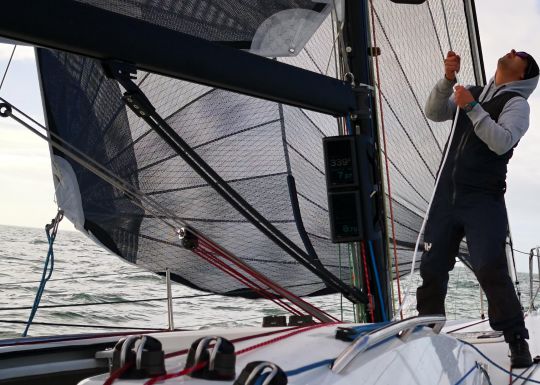
How do I use the bas??
We'll start by tucking in the mainsail with the sheet and then adjust the leech twist with the downhaul. It must be tensioned so that the top batten is more or less parallel to the boom. If it is too tight, the top batten will disappear behind the mainsail . To obtain the correct setting, simply shock the downhaul until the top link reappears.
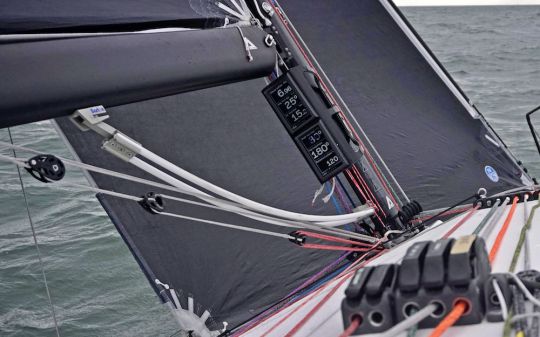
Is the downhaul indispensable on all bateaux??
There are, however, some exceptions with regard to the use of the vang. These concern multihulls and some very large monohulls. These boats have a particularly long mainsail track making the vang less necessary. Indeed, with this type of configuration, shocking the carriage makes it possible to regulate the power properly by playing on the incidence of the sail , while keeping the sheeting tension.
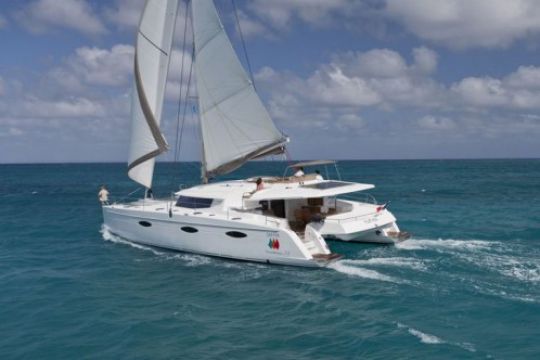
However, on these boats, the shrouds are often anchored well aft of the mast, which prevents the mainsheet from being easily shocked. A downhaul is therefore always useful, as it allows the boom to be shocked as much as possible before the rig becomes a problem. This is why almost all high-performance boats have a boom vang.
What's a vang for rigide??
Rigid downhauls allow the boom to be raised mechanically. For racers, this is particularly interesting in light winds, as the weight of the boom can stretch the leech when you would like to twist the sail . In addition, if the boat is not equipped with a lazy jack or topping lift, the downhaul will support the boom while reefing and folding the sail .
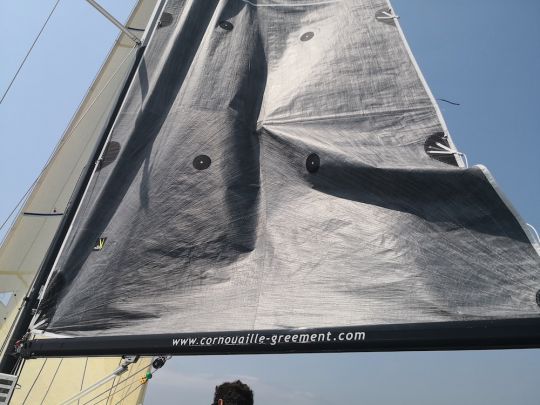
Do I Really Need a Boom Vang?
We get a lot of great questions through our Ask the Expert portal and sometimes they make for great articles. Here are Quantum's David Flynn's insights for Mark A. and everyone else who's wondered about how to properly use the boom vang.
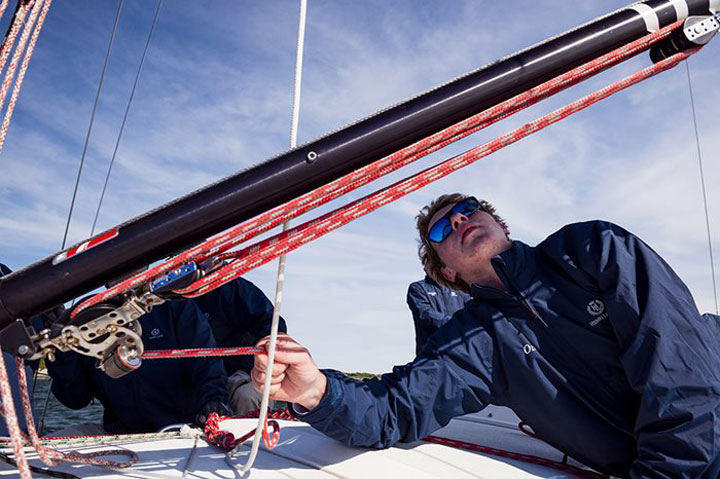
I’ve barely ever used my boom vang. Do I really need one?
Absolutely! The boom vang can be a misunderstood sail control. It takes over the job of pulling down on the boom once the mainsheet is eased. Upwind, the mainsheet pulls down as soon as the boom is over the traveler. Controlling the boom height determines twist, or the shape of the mainsail leech.
If you don’t use the boom vang in all but the lightest conditions, the boom will rise up as it is eased out and the sail will twist off, spilling power out of the top of the sail. This is okay when you have too much heel and helm, but not when you need power. Not taking advantage of your boom vang also limits how far out you can ease the sail. If the top is twisted off, it will run up against the upper shrouds and wrap itself around the stay, which prevents you from letting out the sail as far as you would like. The golden rule of thumb: Use enough vang to keep the top batten parallel to the boom. If it is too tight, the top telltale will stall.
There are a few exceptions however when it comes to boom vang use. The first has to do with multihull boats, which have a traveler that runs the entire width of the boat. With this type of boat, letting the traveler down allows the mainsheet to continue to do the job of pulling down and controlling twist. The length of the traveler lets the boom go a long way out before it starts to lift. Also, most multihulls have upper shrouds that are quite far aft, which prevents easing the mainsheet very far. A vang still helps, however, as it allows maximum ease on the boom before the shrouds become an issue.
The other exception has to do with high-performance planing boats that use asymmetrical spinnakers (Melges 24s, 32s, and C&C 30s, etc). To promote planing and to match the leech of the asymmetrical spinnaker when reaching high angles, a huge amount of twist is required. With this type of boat, you have to ease the vang (until it is almost off) to induce twist, then overshoot and pump the mainsail to promote planing.
If you’d like to know a bit more about mainsail twist (another sailor had a question about it, too), read more here .
The Discussion
We would be very happy to supply branded muggi drinks carriers made from recycled waste ocean plastic! www.muggi.co.uk

Us, too. We pour that passion into each of our newsletters to help you enjoy sailing even more.
Wiktionary.org offers this defintion of the word vang .
Although the etymology is all very interesting. The latter is the one we are the most interested in. Below is a good video describing the benefits of the boom vang and when to use it.
[youtube https://www.youtube.com/watch?v=C31nGzO54O4&w=560&h=315]
The Boom Vang , in its simplest form, is a block and tackle arranged in such a fashion that it applies downward force (also upward force, see rigid vang) to the boom. This will allow the sailor to control the tension of the leech at all points of sail, regardless of the boom’s sheet tension.

RIGID VANGS – Most modern day cruisers and racers alike will use a version of this called a rigid vang. A rigid vang, a.k.a. hard vang, or boom kicker, gets its name because it not only is able to haul the boom down but also pushes it up. This is very handy for a few reasons. The ‘main’ reason (pun intended) is it allows the user a quick way to de-power the booms sail if needed and also helps to support the boom much like a boom topping lift. The last part makes reefing, dousing and storing of the boom all a bit easier.
In taking a look at who’s making these rigid vang systems we find no shortage in manufacturers: Boom Kicker , Barton Boom Strut , Bamar Rigid Vang , US Spars/Z Spar Vang , Selden Rod Kicker , Hall Spars Quick Vang , Vang Master , Forespar Yacht Rod , and Sparcraft Vang . Those are just the mechanical vang makers of the world (and I’m sure I’ve missed some).
On the hydraulic end of things, there are far less manufacturers. If your boat is already equipped with a hydraulic system of any kind you’ll likely recognize one of these brands: Navtec , Sailtec , Selden , and Harken , which are all makers of high quality hydraulic systems…including vangs.
Let us just focus on the ones that we know best and sell the most of here at The Rigging Company!

Forespar Yacht Rod is a tried and true system and our most popular model yet. It may not be the lightest or sleekest out there, but this vang has earned it’s rank among one of the most dependable in the rigid vang market. It is well suited for just about any racer/cruiser or dedicated cruising boat out there. The yacht rod uses a dependable coil spring as the return. Forespar vangs are adjustable, utilizing a very coarse adjustment (about every 4″) via a fast pin which allows the user a tool-less way to adjust the spring pre-load or boom kick height. The vang is constructed of one smaller anodized aluminum tube and one larger painted aluminum tube with cast anodized ends. Pricing is around the $870 – $1600 range, and they are available in just 3 different sizes. Mast brackets, block and tackles, boom lugs, all sold separately.

Hall Spars Quick Vang has also been around for a long time. Although Hall USA has recently announced its closing of business , I think shoppers will still find an inventory of these super high quality vangs with various distributors throughout the US. The Hall Spars Quick Vang has always had a great reputation, and their most recent iteration is even better. Typically, this vang is found on racer/cruisers and dedicated racing boats. Although there is no reason this couldn’t be found on a cruising boat in my opinion. This vang also offers a coil spring as the return mechanism. The springs pre-load can be finely adjusted to set the boom’s kick height (hex keys required). It consists of completely anodized aircraft grade aluminum tubing with solid aluminum machined ends. These systems can vary in price from $1000 to $2800 and are available in 7 different sizes/configurations. Purchase block and tackles are always included, varying from 8:1 to 60:1 depending on boat size and sail requirements. As with all of these systems, mast brackets and boom lugs are purchased separately.

Selden Rodkicker vangs have also been around a very long time and are rigged on many different styles of boats. It is likely they are equipped on more boats than any of the other manufacturers, from the club racer/cruiser, to the dedicated match racer, to the varying ranges of production cruising boats found in today’s sailboat market. Selden’s approach is slightly different in that it uses a gas spring (much like your gas strut on your hatchback) as the return. They also use a very attractive rectangular extrusion instead round tubing like Forespar and Hall. Selden’s Rodkicker vang does not offer any spring height adjustment. The ends are made of cast anodized aluminum (like Forespar). Price wise these are some of the most affordable systems on the market, ranging from just under $300 up to $1600 (hence their popularity). The Selden vangs come in 4 different sizes, and offer a soft and hard spring option within each size (they also offer the no spring option, but what’s the point? ). Purchase block and tackles, mast and boom brackets must be bought separately.

Hydraulic Vangs – Amongst the various hydraulic vang manufacturers you will see very similar design, functionality, and construction. It seems that Navtec, who also recently closed their doors , was the grandfather of all sailboat hydraulic system and cylinder design. The three big players left (see links at the top of this article) all have their own unique features and benefits, but are for the most part based on the same (Navtec) design. Whether we are talking about a double acting push pull vangs (reserved primarily for larger yachts with heavy booms) or gas return vangs, the gist is the same. There is a stainless steel piston rod with an aluminum piston that rides inside of an anodized aluminum cylinder/body. This is all accompanied by a series of seals that will need to be serviced/replaced once in while to keep things….sealed. The big deal is that all of these hydraulic vangs require the boat to be plumbed with hoses, a reservoir and a control panel that houses the pressure gauge and pump at a minimum. Besides just a basic vang cylinder (no plumbing, brackets, lugs or panels) costing as much as the most expensive mechanical vang mentioned above, these systems HAVE to be professionally installed thus making them the most expensive, but also the most robust option, by far.
~Some Final Thoughts~
All rigid vangs especially when properly installed and maintained will last a very (very) long time. Keep in mind, typically anything using fluid (and or gas) and seals will require service/ repair over time. One thing that all vangs require, regardless of whether choosing a simple block and tackle, mechanical, or hydraulic system, is for them to be installed properly; ensuring a properly mounted mast bracket and boom lug, rigging the vang in the correct orientation (not upside down), all the while achieving the appropriate boom to vang angle (approximately 30-45 degrees). This will ensure functionality, longevity and ease of use.
Have a question about which system might be right for you? Need your hydraulic vang serviced? Talk to our experienced sales staff for more information.
Thanks for the read. See you next time.
Similar Posts
Vendee globe crosses the equator.
Check in with the fleet for day 12 highlights. The weather is still warm, but the competition keeps shrinking as Zbigniew “Gutek” Gutkovski of Energa had to retire from the race due to a non-working auto helm .Thanks VendeeglobeTV for the much needed american translation. [youtube http://www.youtube.com/watch?v=2wqiqdLMa-E&w=560&h=315]
Extreme 40’s Hit Brazil
These are the highlights from act 8 in beautiful Rio De Janeiro. Torben Grael, skipper of Team Brasil and home town hero could not make it happen. Leigh Mcmillan of The Wave Muskat takes the double and probably has the best finishes for 2012. Great job, Team Muscat! I can’t wait to catch the action next year in Oman……….

Panerai Classic Yachts Challenge
Last week, on the Solent, a strait that seperates the Isle of Wight from the British Isles, comes a regatta that draws some of the world’s most beatiful classic yachts. Cowes play’s host to the most important event in the United Kingdom for classic yachts, the Panerai Classic Yachts Challenge. Enjoy this little video for…
Keeping up with the Cup
……….and Team USA is barely keeping up with Emirates Team New Zealand. The American team finally pulled off their first victory in yesterday’s last race. The Oracle sponsored team is going to have to maintain this trend for a while in order to stay “in-the-swing-of-things”. The current score is 3 to -1, New Zealand. Each…
Chain Plate Service Anyone?
YIKES! [youtube http://www.youtube.com/watch?v=7iKRiBShhlQ&w=420&h=315] If it inspired you to consider your chainplates then read here for more information on chainplate service and inspection. ~T.R.C.
Team Groupama Dismasted!
In typical Extreme Sailing Series fashion, Act 1 kicks off with no shortage of collisions and wipeouts. The race took place in Singapore Harbor last weekend. Day 3 delivered possibly one of the event’s most dramatic moments in its eight-year history. The home Team Aberdeen Singapore caught a huge gust near the finish line and plowed…
Leave a Reply Cancel reply
Your email address will not be published. Required fields are marked *
Save my name, email, and website in this browser for the next time I comment.
Hi, I am chasing a vang for my Cape 35 that supports the boom. Eye to eye for the band is 1700mm. Cheers, John.
We’d be glad to help. Any vang from any of the manufacturers listed in the article should work. Although some have different pin to pin measurements, most are adjustable, and are about the same for the given size unit. Can you send us pictures of what you have now for a boom and a mast attachment? Email [email protected] . Is there a specific manufacturer that you might prefer based on the article? Let us know in an email and we can set you up a complete DIY solution with instructions after we answer a few questions.
Thanks for Choosing…
Greetings, looking for a Hall Spars cast aluminum vang boom lug to replace mine which deformed and failed. It attaches to the underside of the boom with eight 5/16″ machine screws. Older model which came with a 1988 Sabre 38 MkII. Thank you.
Hey Carter, Thanks for contacting us, it took me a while and we’re super busy, but I have some info….
For the boom portion there are still parts available. Pricing is coming your way, but first let me know which on you need the externally mounted one one internally mounted one.
Use [email protected] to let us know which you would like and we’ll will get pricing and ship one out to you.
Thanks and We Hope that Helps, ~T.R.C.
Hi there, thanks for the reply. It’s an external lug with 8 fasteners. Here’s a photo:
https://www.dropbox.com/s/uicq8ctizs3eoyg/20180603_172037.jpg?dl=0
$219 in stock. Give us a call and we’ll get one shipped to you.
I am trouble shooting a Navtec boom vang. Vang does not pressurize. Trying to determine if the cylinder seals need replacing or the actual vang seals.
My advice is that if the cylinder is not holding pressure, you just re-build the entire unit and re-charge the return. Then we test the unit overnight. There are complete seal kits available for this. We recommend professional certified service to do this. Please let us know if we can help further.
Username or Email Address
Remember Me
Lost your password?
Review Cart
No products in the cart.

- Privacy Overview
- Strictly Necessary Cookies
This website uses cookies so that we can provide you with the best user experience possible. Cookie information is stored in your browser and performs functions such as recognising you when you return to our website and helping our team to understand which sections of the website you find most interesting and useful.
Strictly Necessary Cookie should be enabled at all times so that we can save your preferences for cookie settings.
If you disable this cookie, we will not be able to save your preferences. This means that every time you visit this website you will need to enable or disable cookies again.

- Find A School
- Certifications
- North U Sail Trim
- Inside Sailing with Peter Isler
- Docking Made Easy
- Study Quizzes
- Bite-sized Lessons
- Fun Quizzes
- Sailing Challenge

Tips From The Teach: The Boom Vang
By: Zeke Quezada, ASA Cruising Tips

Elbert “Ash” Ashbaugh
We all have questions and it seems like a boat is a perfect place to be perplexed by a lack of knowledge even if you are a salty veteran of the sea. Not to worry, our resident expert, Elbert “Ash” Ashbaugh, can help answer your questions and help you spend more time sailing and less time thinking about those pressing issues that are keeping you up at night.
Q: Hi Ash! I have a boom vang that I have never even touched! What am I supposed to do with this thing?
Ash: As a general rule, a boom vang helps shape the sail. On an upwind leg, especially if you’re overpowered, tighten the vang to depower the main by flattening the sail.
On the downwind side of life, before you bear away, ease the vang — this will make the mainsail fuller. Then trim the main so the top batten of the sail is parallel with the boom.
That’s an extremely basic overview, but the boom vang is important, so experiment and learn!
Q: I have to confess, sometimes I hear other boats sounding horns and I don’t know what’s going on. What am I hearing?
Ash: You’re not alone in not knowing what these horn signals mean, but it’s really crucial to know a few of these important ones. If you hear five short blasts that means, “I’m not sure of your intentions.” In other words, you’re making someone nervous and you need to clarify whatever you’re doing.
You might often hear 1 short blast. Keep your head up and understand that the boat you’re hearing is altering its course to starboard. If it is two short blasts, they are altering their course to port.
There you have it. You should know that there are sound signals that are different depending on whether they are in international or US inland waters, but these examples apply to both and are the more common and relevant of the sound signals that you’ll hear in your day to day travels.
Oh, and also be mindful that while it’s usually an actual air horn that you’ll hear, it could also be the sound whistle. Small boats often carry whistles.
Tip From the Text – A Tip from ASA’s Coastal Cruising Made Easy Remember! A stern light arc is 135-degrees. This arc of white light visibility is the same as the overtaking zone. So when you are sailing at night, visualize that area and use it to help determine if you are overtaken or overtaking. Sailing is a thinking person’s game! Always watching, calculating and remembering!
Related Posts:

- Learn To Sail
- Mobile Apps
- Online Courses
- Upcoming Courses
- Sailor Resources
- ASA Log Book
- Bite Sized Lessons
- Knots Made Easy
- Catamaran Challenge
- Sailing Vacations
- Sailing Cruises
- Charter Resources
- International Proficiency Certificate
- Find A Charter
- All Articles
- Sailing Tips
- Sailing Terms
- Destinations
- Environmental
- Initiatives
- Instructor Resources
- Become An Instructor
- Become An ASA School
- Member / Instructor Login
- Affiliate Login
× You are using an outdated browser. Please upgrade your browser to improve your experience.
We Ship Worldwide! | FREE SHIPPING! for US Continental orders over $99. Click for details.

Shopping Cart
Your cart is currently empty..
FREE SHIPPING! for US Continental orders over $99 click for details

A boom vang or kicking strap on a sailboat used to exert downward force on the boom and thus control the shape of the sail. Boom vangs helps control boom height which determines twist, or the shape of the mainsail leech during different wind conditions.
Sailboat Block & Tackle sets come with both of the blocks and a cleat to create a full boom vang system in one product. Simply select the purchase that you need and the working load based on your boat size.
If you are expecting a lot of light wind sailing and want to add some extra shape to your leech, add a rigid boom vang to hold up your boom so you don't have to. Instead of having to install and remove a topping lift, just keep a Sailboat Rigid Boom Vangs on your boom to keep it up even while you are gone.
Hydraulic Boom Vangs are used on larger sailboats and controlled by manual or electric hydraulic pumps.
Find Boom Vangs at MAURIPRO Sailing. We are your go-to online store for all sailboat equipment!
MAURIPRO Sailing, your direct access to Boom Vangs and all your other sailing and boating needs.
Copyright © 2024 MAURIPRO Sailing LLC.

- Sailboat Hardware
- Mainsail Handling
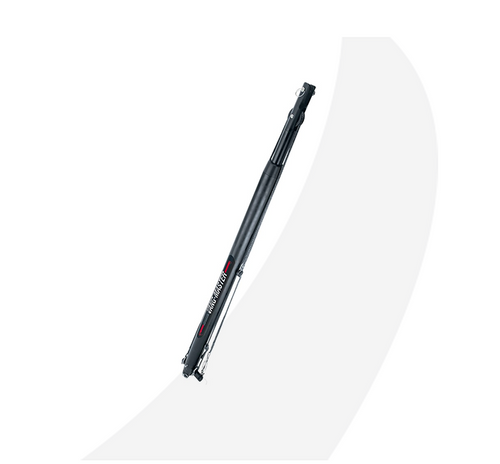
Vang Master Rigid Vang VM8 For Boats 45' To 56' (Closed 72" / Open 84")

Vang Master Rigid Vang VM7 For Boats 45' To 56' (Closed 60" / Open 72")

Vang Master Rigid Vang VM6 For Boats 35' To 46' (Closed 60" / Open 72")
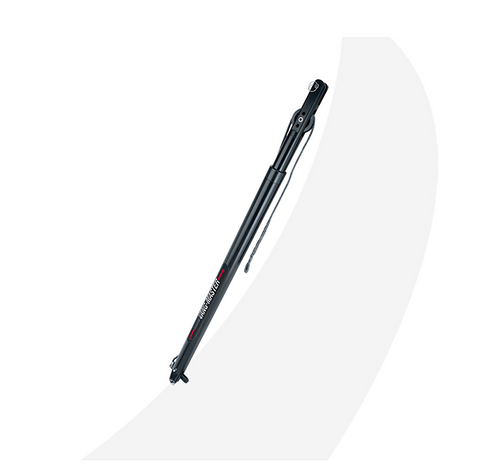
Vang Master Rigid Vang VM5 For Boats 35' To 46' (Closed 48" / Open 60")

Vang Master Rigid Vang VM4 For Boats 26' To 38' (closed 48" / open 58")

Vang Master Rigid Vang VM3 For Boats 26' To 38' (Closed 32" / Open 42")

Vang Master Rigid Vang VM2 For Boats 18' To 28' (closed 40" / open 50")
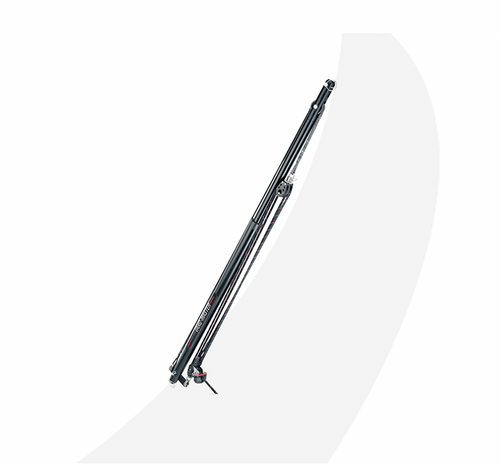
Vang Master Rigid Vang VM1 For Boats 18' To 28' (closed 28" / open 36")

Selden Gas Spring Kit (RodKicker 30/Hard)

Selden Gas Spring Kit (RodKicker 20/Super)

Selden Gas Spring Kit (RodKicker 30/Normal )

Schaefer Boom Vang, 4.1, 1000 Lb (450kg) SWL

Selden Gas Spring Kit (RodKicker 20/Hard)
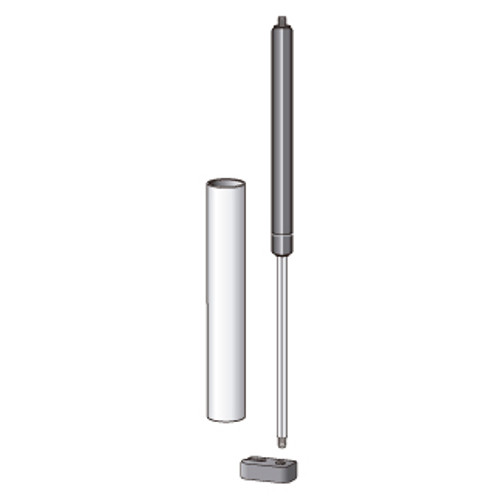
Selden Gas Spring Kit (RodKicker 20/Normal )

Schaefer Boom Vang, 4.1, 900 Lb (410kg) SWL
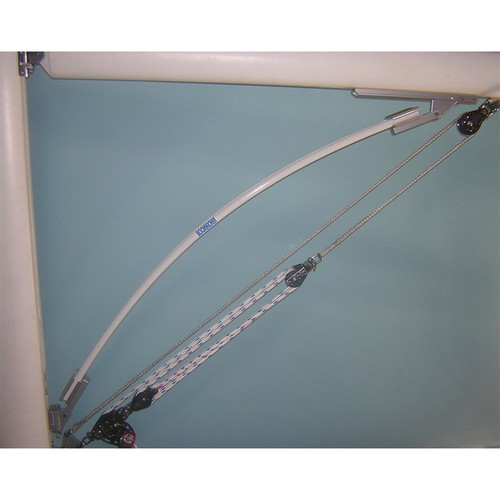
Boomkicker for sailboats 34 to 38' (K01500)

Selden Gas Spring Kit (RodKicker 10/Super)

Boomkicker for sailboats 30 to 34' (K01250)

Boomkicker for sailboats 27 to 30' (K01000)

Boomkicker for sailboats 25 to 27' (K0800)

Please verify you are a human
Access to this page has been denied because we believe you are using automation tools to browse the website.
This may happen as a result of the following:
- Javascript is disabled or blocked by an extension (ad blockers for example)
- Your browser does not support cookies
Please make sure that Javascript and cookies are enabled on your browser and that you are not blocking them from loading.
Reference ID: dc44b2fa-eba1-11ee-9e12-e9f439ecae2f
Powered by PerimeterX , Inc.

Friday 11 April 2014
Moscow metro - spirit of a city (e.p).

No comments:
Post a comment.

- Victor Mukhin

Victor M. Mukhin was born in 1946 in the town of Orsk, Russia. In 1970 he graduated the Technological Institute in Leningrad. Victor M. Mukhin was directed to work to the scientific-industrial organization "Neorganika" (Elektrostal, Moscow region) where he is working during 47 years, at present as the head of the laboratory of carbon sorbents. Victor M. Mukhin defended a Ph. D. thesis and a doctoral thesis at the Mendeleev University of Chemical Technology of Russia (in 1979 and 1997 accordingly). Professor of Mendeleev University of Chemical Technology of Russia. Scientific interests: production, investigation and application of active carbons, technological and ecological carbon-adsorptive processes, environmental protection, production of ecologically clean food.
Title : Active carbons as nanoporous materials for solving of environmental problems
Quick links.
- Conference Brochure
- Tentative Program


Turn Your Curiosity Into Discovery
Latest facts.

7 Things a Hair Drug Test Can Tell You

How to Patent an Idea with InventHelp
40 facts about elektrostal.
Written by Lanette Mayes
Modified & Updated: 02 Mar 2024
Reviewed by Jessica Corbett

Elektrostal is a vibrant city located in the Moscow Oblast region of Russia. With a rich history, stunning architecture, and a thriving community, Elektrostal is a city that has much to offer. Whether you are a history buff, nature enthusiast, or simply curious about different cultures, Elektrostal is sure to captivate you.
This article will provide you with 40 fascinating facts about Elektrostal, giving you a better understanding of why this city is worth exploring. From its origins as an industrial hub to its modern-day charm, we will delve into the various aspects that make Elektrostal a unique and must-visit destination.
So, join us as we uncover the hidden treasures of Elektrostal and discover what makes this city a true gem in the heart of Russia.
Key Takeaways:
- Elektrostal, known as the “Motor City of Russia,” is a vibrant and growing city with a rich industrial history, offering diverse cultural experiences and a strong commitment to environmental sustainability.
- With its convenient location near Moscow, Elektrostal provides a picturesque landscape, vibrant nightlife, and a range of recreational activities, making it an ideal destination for residents and visitors alike.
Known as the “Motor City of Russia.”
Elektrostal, a city located in the Moscow Oblast region of Russia, earned the nickname “Motor City” due to its significant involvement in the automotive industry.
Home to the Elektrostal Metallurgical Plant.
Elektrostal is renowned for its metallurgical plant, which has been producing high-quality steel and alloys since its establishment in 1916.
Boasts a rich industrial heritage.
Elektrostal has a long history of industrial development, contributing to the growth and progress of the region.
Founded in 1916.
The city of Elektrostal was founded in 1916 as a result of the construction of the Elektrostal Metallurgical Plant.
Located approximately 50 kilometers east of Moscow.
Elektrostal is situated in close proximity to the Russian capital, making it easily accessible for both residents and visitors.
Known for its vibrant cultural scene.
Elektrostal is home to several cultural institutions, including museums, theaters, and art galleries that showcase the city’s rich artistic heritage.
A popular destination for nature lovers.
Surrounded by picturesque landscapes and forests, Elektrostal offers ample opportunities for outdoor activities such as hiking, camping, and birdwatching.
Hosts the annual Elektrostal City Day celebrations.
Every year, Elektrostal organizes festive events and activities to celebrate its founding, bringing together residents and visitors in a spirit of unity and joy.
Has a population of approximately 160,000 people.
Elektrostal is home to a diverse and vibrant community of around 160,000 residents, contributing to its dynamic atmosphere.
Boasts excellent education facilities.
The city is known for its well-established educational institutions, providing quality education to students of all ages.
A center for scientific research and innovation.
Elektrostal serves as an important hub for scientific research, particularly in the fields of metallurgy, materials science, and engineering.
Surrounded by picturesque lakes.
The city is blessed with numerous beautiful lakes, offering scenic views and recreational opportunities for locals and visitors alike.
Well-connected transportation system.
Elektrostal benefits from an efficient transportation network, including highways, railways, and public transportation options, ensuring convenient travel within and beyond the city.
Famous for its traditional Russian cuisine.
Food enthusiasts can indulge in authentic Russian dishes at numerous restaurants and cafes scattered throughout Elektrostal.
Home to notable architectural landmarks.
Elektrostal boasts impressive architecture, including the Church of the Transfiguration of the Lord and the Elektrostal Palace of Culture.
Offers a wide range of recreational facilities.
Residents and visitors can enjoy various recreational activities, such as sports complexes, swimming pools, and fitness centers, enhancing the overall quality of life.
Provides a high standard of healthcare.
Elektrostal is equipped with modern medical facilities, ensuring residents have access to quality healthcare services.
Home to the Elektrostal History Museum.
The Elektrostal History Museum showcases the city’s fascinating past through exhibitions and displays.
A hub for sports enthusiasts.
Elektrostal is passionate about sports, with numerous stadiums, arenas, and sports clubs offering opportunities for athletes and spectators.
Celebrates diverse cultural festivals.
Throughout the year, Elektrostal hosts a variety of cultural festivals, celebrating different ethnicities, traditions, and art forms.
Electric power played a significant role in its early development.
Elektrostal owes its name and initial growth to the establishment of electric power stations and the utilization of electricity in the industrial sector.
Boasts a thriving economy.
The city’s strong industrial base, coupled with its strategic location near Moscow, has contributed to Elektrostal’s prosperous economic status.
Houses the Elektrostal Drama Theater.
The Elektrostal Drama Theater is a cultural centerpiece, attracting theater enthusiasts from far and wide.
Popular destination for winter sports.
Elektrostal’s proximity to ski resorts and winter sport facilities makes it a favorite destination for skiing, snowboarding, and other winter activities.
Promotes environmental sustainability.
Elektrostal prioritizes environmental protection and sustainability, implementing initiatives to reduce pollution and preserve natural resources.
Home to renowned educational institutions.
Elektrostal is known for its prestigious schools and universities, offering a wide range of academic programs to students.
Committed to cultural preservation.
The city values its cultural heritage and takes active steps to preserve and promote traditional customs, crafts, and arts.
Hosts an annual International Film Festival.
The Elektrostal International Film Festival attracts filmmakers and cinema enthusiasts from around the world, showcasing a diverse range of films.
Encourages entrepreneurship and innovation.
Elektrostal supports aspiring entrepreneurs and fosters a culture of innovation, providing opportunities for startups and business development.
Offers a range of housing options.
Elektrostal provides diverse housing options, including apartments, houses, and residential complexes, catering to different lifestyles and budgets.
Home to notable sports teams.
Elektrostal is proud of its sports legacy, with several successful sports teams competing at regional and national levels.
Boasts a vibrant nightlife scene.
Residents and visitors can enjoy a lively nightlife in Elektrostal, with numerous bars, clubs, and entertainment venues.
Promotes cultural exchange and international relations.
Elektrostal actively engages in international partnerships, cultural exchanges, and diplomatic collaborations to foster global connections.
Surrounded by beautiful nature reserves.
Nearby nature reserves, such as the Barybino Forest and Luchinskoye Lake, offer opportunities for nature enthusiasts to explore and appreciate the region’s biodiversity.
Commemorates historical events.
The city pays tribute to significant historical events through memorials, monuments, and exhibitions, ensuring the preservation of collective memory.
Promotes sports and youth development.
Elektrostal invests in sports infrastructure and programs to encourage youth participation, health, and physical fitness.
Hosts annual cultural and artistic festivals.
Throughout the year, Elektrostal celebrates its cultural diversity through festivals dedicated to music, dance, art, and theater.
Provides a picturesque landscape for photography enthusiasts.
The city’s scenic beauty, architectural landmarks, and natural surroundings make it a paradise for photographers.
Connects to Moscow via a direct train line.
The convenient train connection between Elektrostal and Moscow makes commuting between the two cities effortless.
A city with a bright future.
Elektrostal continues to grow and develop, aiming to become a model city in terms of infrastructure, sustainability, and quality of life for its residents.
In conclusion, Elektrostal is a fascinating city with a rich history and a vibrant present. From its origins as a center of steel production to its modern-day status as a hub for education and industry, Elektrostal has plenty to offer both residents and visitors. With its beautiful parks, cultural attractions, and proximity to Moscow, there is no shortage of things to see and do in this dynamic city. Whether you’re interested in exploring its historical landmarks, enjoying outdoor activities, or immersing yourself in the local culture, Elektrostal has something for everyone. So, next time you find yourself in the Moscow region, don’t miss the opportunity to discover the hidden gems of Elektrostal.
Q: What is the population of Elektrostal?
A: As of the latest data, the population of Elektrostal is approximately XXXX.
Q: How far is Elektrostal from Moscow?
A: Elektrostal is located approximately XX kilometers away from Moscow.
Q: Are there any famous landmarks in Elektrostal?
A: Yes, Elektrostal is home to several notable landmarks, including XXXX and XXXX.
Q: What industries are prominent in Elektrostal?
A: Elektrostal is known for its steel production industry and is also a center for engineering and manufacturing.
Q: Are there any universities or educational institutions in Elektrostal?
A: Yes, Elektrostal is home to XXXX University and several other educational institutions.
Q: What are some popular outdoor activities in Elektrostal?
A: Elektrostal offers several outdoor activities, such as hiking, cycling, and picnicking in its beautiful parks.
Q: Is Elektrostal well-connected in terms of transportation?
A: Yes, Elektrostal has good transportation links, including trains and buses, making it easily accessible from nearby cities.
Q: Are there any annual events or festivals in Elektrostal?
A: Yes, Elektrostal hosts various events and festivals throughout the year, including XXXX and XXXX.
Was this page helpful?
Our commitment to delivering trustworthy and engaging content is at the heart of what we do. Each fact on our site is contributed by real users like you, bringing a wealth of diverse insights and information. To ensure the highest standards of accuracy and reliability, our dedicated editors meticulously review each submission. This process guarantees that the facts we share are not only fascinating but also credible. Trust in our commitment to quality and authenticity as you explore and learn with us.
Share this Fact:

Moscow Metro Font

Moscow Metro is a multi-line display typeface inspired by the Moscow underground map. It comes in Regular and Color versions.
Moscow Metro is ideal for posters and headlines, neon signage and other artworks.
- Share by email
Designed by: Nadira Filatova Website
License: free for commercial use.


IMAGES
VIDEO
COMMENTS
June 15, 2022. A boom vang is a set of blocks and lines or an adjustable pole used to pull the boom down and shape the sail. The boom vang (or "kicking strap") is a system used to control the shape of the sail. It counteracts the upward force of the boom jack and the mainsail by pulling the boom downward. This results in the ability to ...
A boom vang (US) or kicking strap (UK) (often shortened to "vang" or "kicker") is a line or piston system on a sailboat used to exert downward force on the boom and thus control the shape of the sail. The Collins English Dictionary defines it as "A rope or tackle extended from the boom of a fore-and-aft mainsail to a deck fitting of a vessel ...
The vang allows vertical adjustment of the boom, and is an extremely important tool to shape the main for speed. Tension the vang to tighten the leech, flatten the sail and bend the mast. Cruisers use the vang to keep the boom from rising when sailing downwind and abraiding the main. Typical boat length: Small Boat: 22' - 28' (6.7 - 8.5 m)
As we've reviewed, the vang is the principal tool for controlling twist in the mainsail, which can be a critical part of sail control management. The vang also assists in controlling the height of the boom, and can even, in some cases, provide extra stability for safety. Small but mighty, it only comes into play when you need sharp and ...
Installation instructions. To install a boom vang on a C-22 or similar sailboat: 1. The vang should be installed at a 45 degree angle between the mast and boom. Measure the height of the top of the boom above the cabin roof with the mainsail at full hoist. For a Catalina 22, it should be 39″. 2.
The Vang. Boom vangs provide essential safety and twist control for sailboat mainsails. This article includes explanations and some helpful diagrams to inspire do-it-yourself riggers to design a system that works for them. Cascading block and tackle system: 2:1 wire or single-braid line cascade with 4:1 fiddle block & tackle. 2 x 2 x 2 x 4 = 32 ...
This size Ocean Vang retails for $279, which includes the control line, but not the brackets for the mast ($39) or boom ($42). The vang carries a one-year warranty. Conclusions. For cruising sailors, it's most important that a rigid vang works to support the boom and secondarily to trim the mainsail.
Let the sail bag out some. When sailing downwind in a strong wind, ease the vang to depower the mainsail by allowing the boom to rise and the sail to spill air high up (mainsail "twist"). Bring in the mainsheet if needed to prevent chafing of the sail against the shrouds and spreaders. After dropping the mainsail, raise the boom to give ...
Using the Boom Vang: Advanced Sailing Video Lessons. Part of the series: Advanced Sailing Lessons. Learn how to use the boom vang in this free video on saili...
The vang, together with the mainsheet, is one of two ways of controlling the boom height, which determines the twist. If you do not use the downhaul (except in light winds), by shocking the sheet, the boom will rise and open the leech wide, releasing all the power from the top of the sail. This is ideal when the boat heels excessively and ...
The boom vang can be a misunderstood sail control. It takes over the job of pulling down on the boom once the mainsheet is eased. Upwind, the mainsheet pulls down as soon as the boom is over the traveler. Controlling the boom height determines twist, or the shape of the mainsail leech.
The Boom Vang, in its simplest form, is a block and tackle arranged in such a fashion that it applies downward force (also upward force, see rigid vang) to the boom. This will allow the sailor to control the tension of the leech at all points of sail, regardless of the boom's sheet tension. Although more purchase may be necessary, typically ...
On an upwind leg, especially if you're overpowered, tighten the vang to depower the main by flattening the sail. On the downwind side of life, before you bear away, ease the vang — this will make the mainsail fuller. Then trim the main so the top batten of the sail is parallel with the boom. That's an extremely basic overview, but the ...
A boom vang or kicking strap on a sailboat used to exert downward force on the boom and thus control the shape of the sail. Boom vangs helps control boom height which determines twist, or the shape of the mainsail leech during different wind conditions. Sailboat Block & Tackle sets come with both of the blocks and a cleat to create a full boom ...
1-15 results of 15. Fisheries Supply is your premier supplier of rigid boom vangs from top brands. We offer a full range of quality boom vangs for sailboats, including the Rodkicker from Selden, the Yacht Rod from Forspar or the Boomkicker - all rigid vangs. We also stock a variety of boom vang hardware and parts - everything you need to ...
Boom vangs from Vela at the best price. One design or custom built available. Boomkicker, Vang Master, and Schaefer. The best boomvangs from Vela. ... Mast & Boom Fittings; Sailboat Keelbands; Sailboat Tracks; Self Tacking Jib System; Sliding Fairlead Systems; Sliding Systems; T-Tracks; Track End Stops; Track Slides; Tracks; Traveler Cars;
36 results for "boom vang sailboat" Results. Price and other details may vary based on product size and color. 4:1 25mm / 1" Micro Mainsheet System Boom Vang w/Line Various Size & Length. $94.87 $ 94. 87. $13.99 delivery Feb 16 - 20 . Or fastest delivery Tue, Feb 13 .
Boat vangs generally consist of a block and tackle system designed to pull the boom down. Rigid vangs also include block and tackle systems to pull the boom down, but also hold the boom up in place of a topping lift. Boomkickers also act as boom supports and eliminate the need for a topping lift. They are designed for installation on boats that ...
It has been over a year since first being introduced to Limerick based 4-piece Moscow Metro* through their wonderful debut double-A side containing the tracks "Spirit of a City" and "Cosmos" for free, which sounded near perfect in spite of the band only being together for a few months at the time of recording. Now fast-forward 12 months, and as a result of the initial love for the band, they ...
Catalysis Conference is a networking event covering all topics in catalysis, chemistry, chemical engineering and technology during October 19-21, 2017 in Las Vegas, USA. Well noted as well attended meeting among all other annual catalysis conferences 2018, chemical engineering conferences 2018 and chemistry webinars.
Lanette Mayes. Elektrostal is a vibrant city located in the Moscow Oblast region of Russia. With a rich history, stunning architecture, and a thriving community, Elektrostal is a city that has much to offer. Whether you are a history buff, nature enthusiast, or simply curious about different cultures, Elektrostal is sure to captivate you.
July 14, 2020 featured in Display. Bold Color Cool Creative Cyrillic Geometric Neon Outlined Retro. Download Moscow Metro font, a multi-line display typeface in two styles, inspired by the Moscow underground map. Moscow Metro is ideal for posters and headlines, neon signage and other artworks.